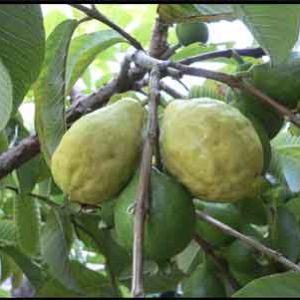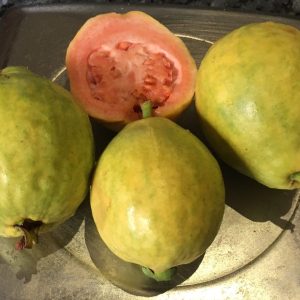Psidium guajava
Guava, tropical guava
Origin
Native to the American tropics but now pantropical to the extent that many countries consider it indigenous. Historical records show they have been grown for millennia in the Americas. Its hardiness has led to it being declared a pest in many regions.
Climate
It thrives in humid tropical climates up to 1500m elevation, but also in sub-tropical areas that don’t have significant frosts. Ideal temperatures and rainfall are 23-28°C and 1000-2000mm pa with distinct wet and dry seasons. The trees may survive drought periods but they stop growing and there can be almost total fruit drop if it occurs during fruit maturation. In colder, more temperate climates, they may briefly lose much of their foliage.
Plant Description
Guava is a low-branching fast-growing perennial evergreen shrub that can grow into a small tree, 3-6m high. Young green shoots are angular. It has pliable branches and smooth peeling bark. The opposite oblong-oval leaves, 10-15cm long with 10-15 pairs of secondary veins, have serrated margins and are smooth and finely pubescent on the upper and under sides respectively. The species is allelopathic, forms a beneficial mycorrhizal association, and has a root system that extends beyond the drip line.
Relatives
It’s in the large Myrtaceae Family that contains 5500 species; other fruiting species include feijoa, pitanga, jaboticaba, cherry guava, hill gooseberry and the many fruiting Eugenia and Syzygium species. Taxonomy of the genus Psidium is problematic but currently there are 91 species, with guava being the most economically important one cultivated for fruit.
Guava is usually diploid (2n=22) with some plants being polyploid or aneuploid.
Soils
Adapted to a wide variety of soils but poor soils result in lower yields. Best pH is 5-7 and although they will grow above this range, deficiency symptoms for Fe and Zn can be expected. Although they perform best with well-drained soils they can tolerate some waterlogging.
Propagation
Seeds are mainly used for breeding or to produce rootstocks for grafting as they don’t come true to type. Marcotting and cuttings are also possible.
Cultivars
As a mainly cross-pollinating species, there is considerable genetic heterogeneity across plants. Nursery stock are often seedlings, but some named varieties available in Australia are: Pink supreme, Thai white (few seeds), China pear and Mexican cream, with many more internationally.
Flowering and Pollination
Axillary flowers develop in spring-summer, usually solitary but sometimes in 2-3 flowered cymes on current season branches. They are hermaphrodite, 2.5-3.5cm wide, have 4-5 white petals, 200-250 stamens and a single central exserted style. The inferior ovary has 4-5 carpels, each containing numerous ovules. The species is capable of within flower selfpollination before anthesis, but although almost all these set fruit, most abscise within 30 days, possibly because of pollen/ stigma immaturity and/or restricted pollen access for ovule fertilisation. Pollination across flowers on the same plant or from different plants also results in good fruit set and a larger proportion of these (>60%) are carried through to maturity. Molecular genetic work has shown that >80% of fruit in mixed orchards is the result of cross-pollination, which produces larger fruit. There are no nectaries & bees are the most important pollinators.
Cultivation
They grow best in full sun and respond well to ample fertilization. When young they should be given 100-200g of NPK 3-4 times pa. When mature, fertilizer is usually given after harvest, increasing according to tree size. One rule of thumb is 180g of 10:6:10 NPK/cm of trunk diameter at knee height. Micronutrients will also need to be given in the poor soils in coastal WA. Two calcium nitrate sprays (0.6%) 60-80 days after anthesis & again a fortnight later can increase the flesh sugar/acidity ratio & post-harvest storage life. Weed control is crucial with young plants and as always, mulching helps.
Wind Tolerance
Guava is a hardy plant but if strong winds are common it will benefit from windbreaks, especially for those plants propagated by cuttings or marcotting.
Pruning
Commercially, single-trunked trees are preferred for ease of harvesting, but for the home grower, the bush or vase form is favoured. Maintaining light penetration throughout the canopy is important. Heading back branches results in long whip-like growth with low flowering; cutting at forks gives better results. Horizontal branches are more productive than vertical and fruit size is enhanced with fruit thinning.
The Fruit
This is a variably-seeded globose, ovoid or pyriform climacteric berry, 2-5-10cm in diameter, with a small remnant 4-5 lobed calyx at the apex. Skin colour changes from green to yellow when ripe and flesh can be white, yellow, salmon or pink, enclosing the small seeds. Some selected varieties, often triploids, have very few seeds; others have been chosen for different sugar to acid ratios. Edible flesh contains up to 15% carbohydrates, good fibre and vitamin A levels and several times the level of vitamin C as citrus, with most being close to the skin. It has higher levels of lycopene than watermelon.
Fruit Production and Harvesting
Seedlings may take 2-5 years to begin flowering, grafted plants less. Depending on climate and conditions, fruit can take 4-6 months to mature. Dessert fruit are usually harvested when half-coloured ripe, and handled with care as they’re easily bruised. They can then be stored for 2-3 weeks at 8-10°C; at 20°C this reduces to about a week. Well-managed mature trees are very productive and can yield more than 60kg/tree over a staggered harvest season.
Fruit Uses
They are consumed fresh or in dried forms, and as purees and juices per se or in baked products. Their high pectin content means they readily set jams and jellies.
Pests and Diseases
Medfly is the worst pest and will require baiting or spraying to control; thrips and root-knot nematodes may also cause problems. Diseases include anthracnose, made worse in humid environments, with other possibilities being blossom end rot and guava wilt.
Comments
In south west WA these plants are super productive. To avoid wastage and in addition to fresh consumption, you’ll have to develop appropriate processing and storing strategies if you can’t give away bucket loads of fruit. Medfly will have to be controlled. Endeavour to obtain a named cv rather than a seedling of unknown parentage with variable production and fruit quality.


